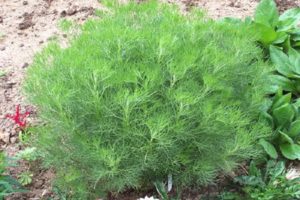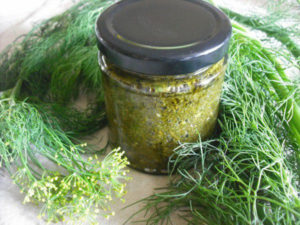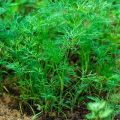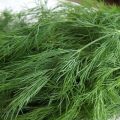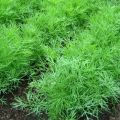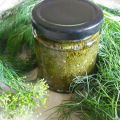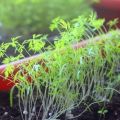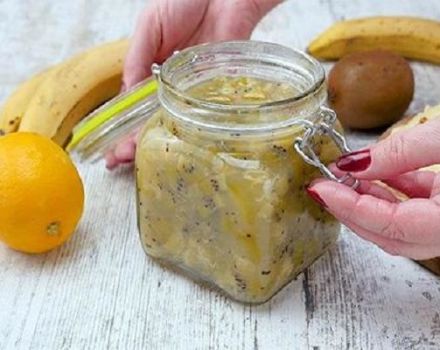Description of varieties of bush dill, recommendations for growing and care
Breeders involved in the development of bush dill argued that in order to provide a family with fragrant grass, only 20 seeds of this crop need to be planted. Having heard about the valuable characteristics of dill, many gardeners began to grow it. However, they all failed. The stems were short, the leaves were few.
None of the land owners paid attention to the peculiarities of agricultural technology. The seeds of bush dill are rich in essential oils, so they do not germinate for a long time. The grass does not gain mass if planted densely. The greens are completely cut off when flowers appear.
Features of culture
Shrub dill grows up to 1.5 meters in height in a garden bed, in a greenhouse - up to 3, has an original shape. Low internodes are closer than those of common varieties. Additional lateral shoots are formed in the leaf axils. Peduncles form closer to autumn, and the seeds in the middle lane do not have time to ripen.
Bush dill needs a lot of light, fertile loose soil, in the lowlands, in dense soil, it develops poorly. Culture growth slows down at high temperatures, the optimal indicator is 20 degrees. From one plant, 100 to 200 grams of greens are cut off. Regular dill is harvested when the spice is young and fresh, and there are few essential oils in it. Shrub varieties have time to accumulate these substances. Leaves 45 cm long, partially cut off when the plant blooms, removes everything. They are more aromatic and contain a high percentage of useful components.
Varieties of bush dill
It is difficult to imagine a table without spicy herbs. In addition to its pleasant smell, it is valued for the presence of vitamins of groups B, A. E, RR, C.
The leaves and stems of the plant are rich in:
- calcium and potassium;
- phosphorus and copper;
- magnesium and iron;
- zinc and manganese.
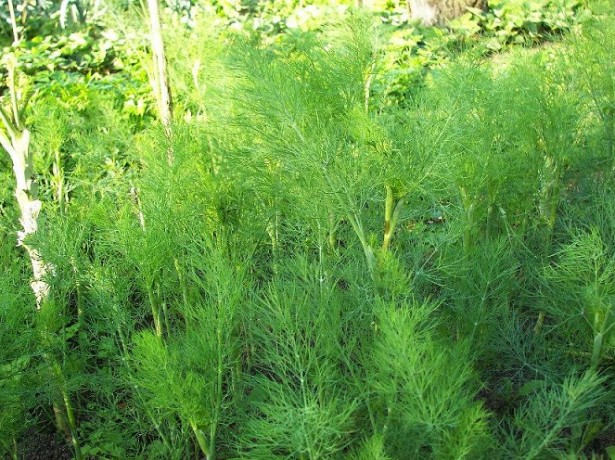
The first variety of bush dill, bred at the end of the last century, gave a lot of greenery, additional shoots formed in the axils of the main leaves at Kibray. Then Buyan and Salyut appeared.
In addition to high yields, which is an advantage of these varieties, there were also disadvantages:
- The roots were often rotted.
- The bush had an unfortunate shape.
- Thin stems broke from the touch.
Over time, breeders took into account the shortcomings and brought out Bouquet, Amazon, Fireworks, Alligator.
The early ripe Aurora variety is cut for greens a month after the sprouts emerge. Many leaves are formed on the spreading bushes, the crop is harvested several times per season.
Dill Amazon ripens after 40 days.More than 6 kg are harvested from a square meter of a bed for the preparation of spices, for greens - about 4. The variety has large leaves.
At the Fireworks, up to 4 stems are formed from each node. The crop is harvested one and a half months after the emergence of the first shoots. This type of dill has a sweetish aroma.
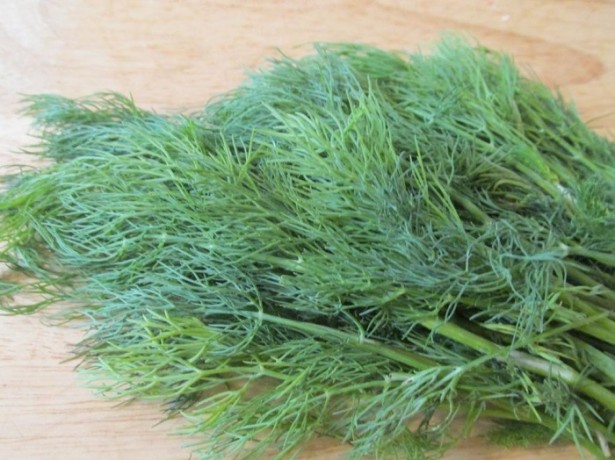
The Buyan variety has a long growth period, builds up a large mass of greenery. Seeds are planted at a decent distance, the bushes are thinned out.
Dill has a bouquet of tender and large leaves, inflorescences are laid slowly, the stem height is about 80 cm. The aromatic spice is cut off after 30–40 days.
Late-ripening Salute is valued for its excellent yield, but it has a drawback - the seeds not only do not ripen, but also do not form.
Outdoor cultivation
Before planting bush dill in the garden, you need to study the features of agricultural technology, select a variety, a growing method and find a suitable place on the site.
The crop can be sown directly into the ground and done in the spring or by the end of autumn. She is not afraid of frosts down to minus 6.
To speed up the appearance of fresh greens, seedlings are first prepared, which are then transplanted to the garden.
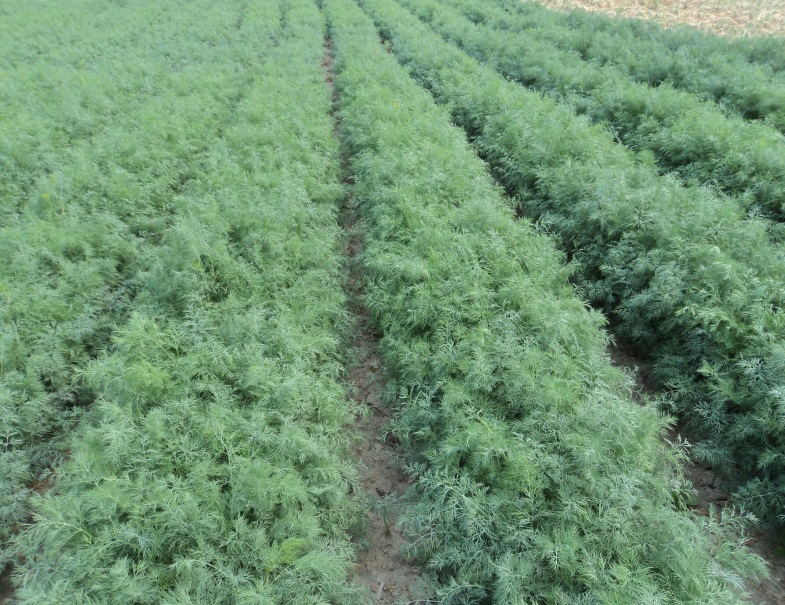
Preparing the seeds
Shrub dill blooms in late summer. In the middle lane, the grains do not ripen and do not germinate. It will not be difficult to buy them at a retail outlet or grow a seedling crop. Essential oils prevent the rapid growth of sprouts. At low temperatures, seedlings are delayed by two weeks.
Experienced gardeners are advised to soak the seeds for a day in warm water, which must be constantly changed so that it does not cool down. Before planting, the pickled grains must be dried, laid out on fabrics, then the sprouts will hatch in 2 or 3 days.
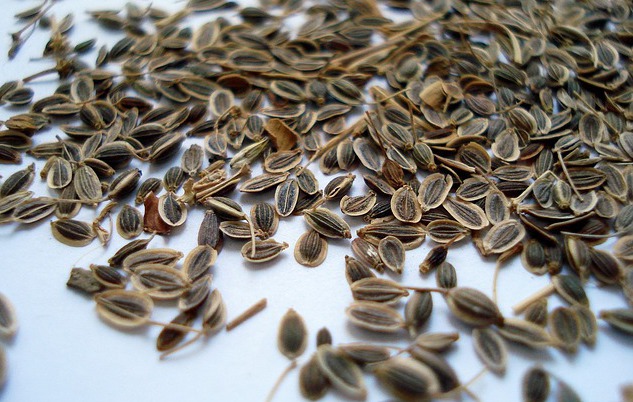
Preparing the soil
All varieties of bush dill adore fertile land, do not tolerate stagnant moisture, and an increased level of acidity. Feeding with organic and mineral substances helps to improve the structure of the soil. The following is added per square meter of the plot:
- urea - 20 g;
- superphosphate - 30;
- humus - 2 kg.
Thanks to such fertilizers, the layer of fertile soil will increase, which serves as the necessary conditions for the growth and development of bush dill. The roots of culture go deep into the earth.
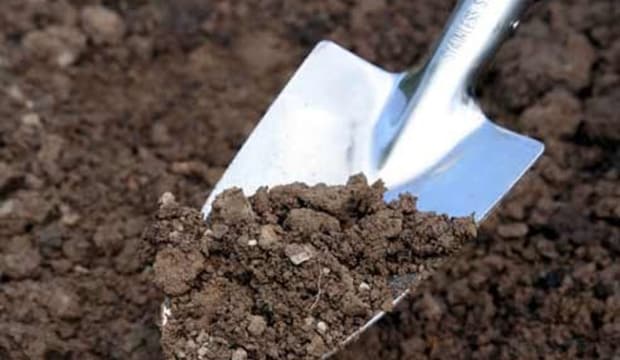
We sow the seeds
In April and early May, the beds are prepared and the soil is watered abundantly. After that, grooves are made, leaving 20 centimeters between them. Seeds are sown every 3 cm. From above it is necessary to sprinkle a thin layer of peat, slightly compact the earth. The sprouts will come out faster when the bed is covered with plastic.
If you plant a crop thicker, additional leaves will not form, instead of a bush variety, ordinary dill will grow.
Plant care
Sentsa are thinned several times, leaving at first 5 cm between them, and at the end 20. Like other types of spicy herbs, the culture needs care, which includes;
- weeding;
- weed removal;
- moisturizing.

Bush dill is watered once a week, no more than 5 liters of water is needed per square meter. The plant is planted in fertilized soil, so there is no need to feed it. With an excess of nitrogen in the soil, nitrates accumulate in the leaves and stems of the crop. They turn yellow with a lack of this substance. Several times per season, you can add urea under the roots (a spoon on a bucket of water). Weed control is carried out until at least 3 leaves are formed on the stem.
Growing through seedlings
In the middle lane, bush dill is sown starting in April. To cut the greens faster, you need to use a different growing method. About a month before moving into open ground, soil is poured into wooden boxes, grooves are made in it every 2 cm, where seeds are sown. They are sprinkled with earth on top, watered, covered with foil. When 5 leaves appear, the seedlings are sent to the garden bed.
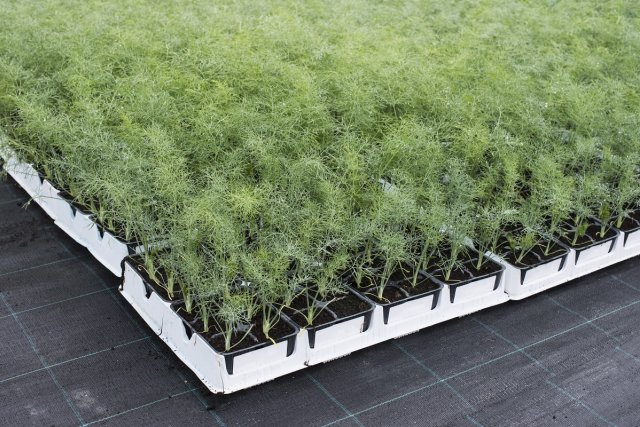
Growing bush dill at home
Even if there is no summer cottage or suburban area, you can always have greenery at hand. To do this, several varieties of dill with different ripening periods are sown in a pot or container. The container is placed on the windowsill, in the summer months - on the balcony.
The sun's rays should hit the plant for at least 6 hours, in poor lighting, a fluorescent lamp is installed, in winter it works all day.
Subject to the optimal air temperature and humidity, the correct choice of seeds and soil in the house or apartment grows bushy dill. Every day the family will be able to consume fragrant greens rich in vitamins and minerals.
Harvesting
Shrub varieties are more often grown in a greenhouse than outdoors. If summer, the cool dill will not be thick. In favorable weather, lateral shoots form in the leaf axils, and the crop yield increases significantly. The plant blooms by the end of summer, which allows you to cut off the juicy and fresh spice all season.
